This might be the most spectacular and unique raptor I’ve ever photographed or even seen. In fact there’s no “might be” about it – without qualification, it is. And I even got some pretty decent photos of it in flight.
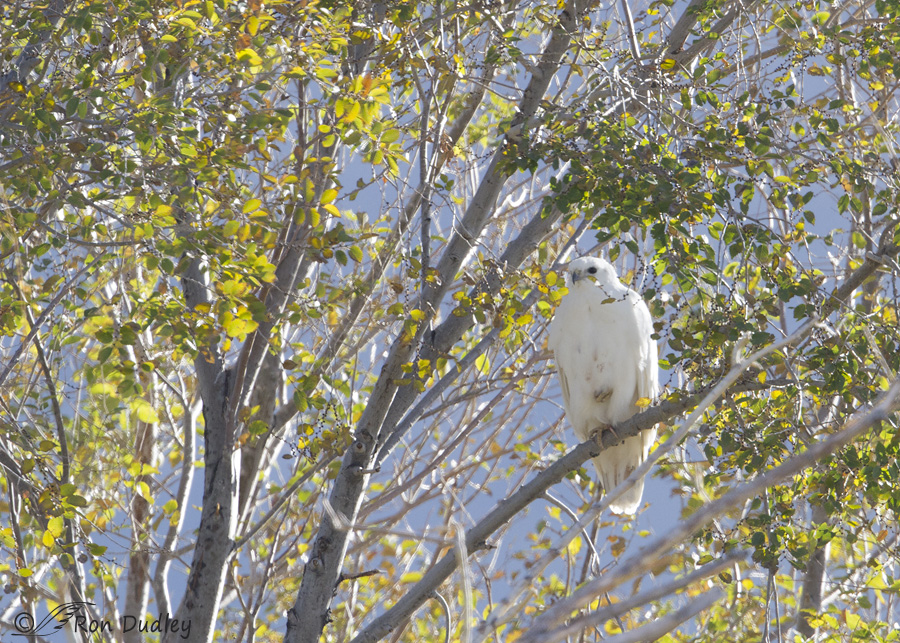
1/800, f/6.3, ISO 800, Canon 7D, Canon EF 500mm f/4L IS II USM + EF 1.4 III Extender, not baited, set up or called in
The excitement started yesterday morning when we spotted something bright white in a far-away tree. My first impulse was to think it was some kind of garbage, perhaps a plastic bag, that had blown into the tree but a closer inspection with my lens revealed it to be a leucistic adult Red-tailed Hawk. Boy, that got my heart thumpin’ and pumpin’! But the bird seemed like it was a thousand miles away (this image has been cropped significantly) and it was buried in the tree so I just sat there in my pickup and watched the small white speck through my lens. And drooled. Dang I was itching to be closer to that bird!
But this time the gods of photography were with me and the bird eventually lifted off and landed on a power pole next to the road I was on.
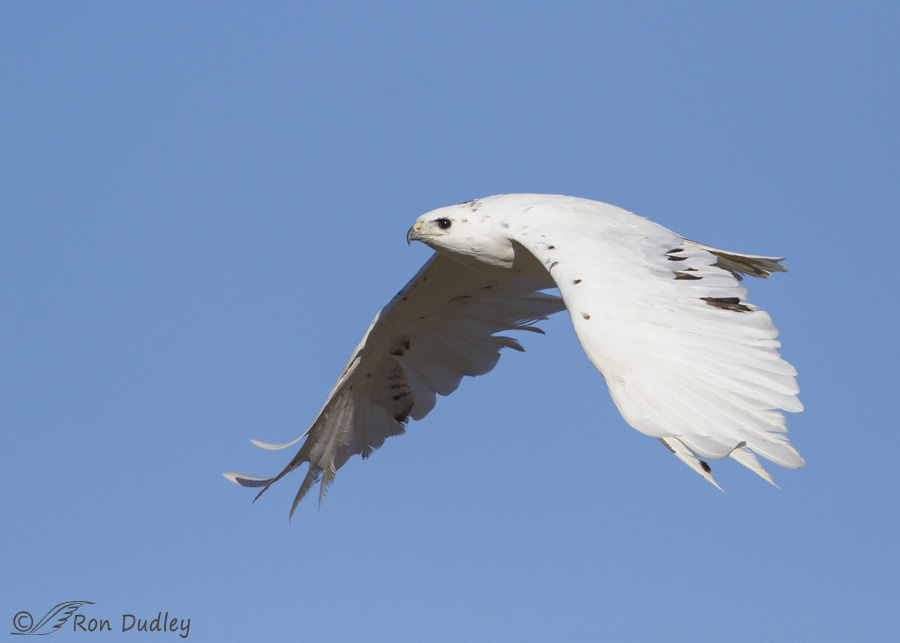 1/5000, f/6.3, ISO 500, Canon 7D, Canon EF 500mm f/4L IS II USM + EF 1.4 III Extender, not baited, set up or called in
1/5000, f/6.3, ISO 500, Canon 7D, Canon EF 500mm f/4L IS II USM + EF 1.4 III Extender, not baited, set up or called in
Typical of me I was fiddle-farting around with my camera settings when the hawk lifted off from the pole so I missed those takeoff shots. But I was able to get several photos I like as it flew down the line of poles and landed on another one. I caught the wings down…
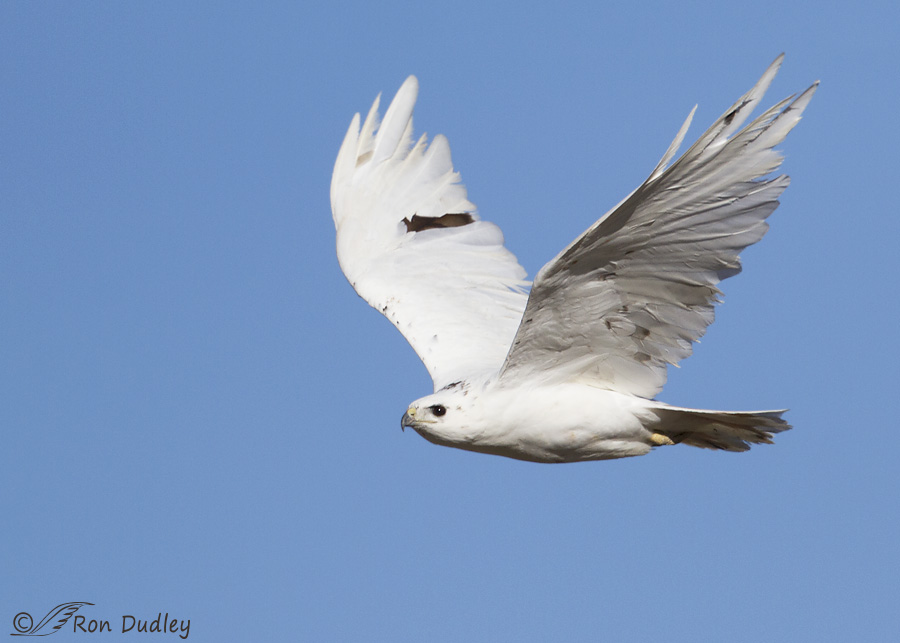 1/5000, f/6.3, ISO 500, Canon 7D, Canon EF 500mm f/4L IS II USM + EF 1.4 III Extender, not baited, set up or called in
1/5000, f/6.3, ISO 500, Canon 7D, Canon EF 500mm f/4L IS II USM + EF 1.4 III Extender, not baited, set up or called in
and the wings up in the next frame.
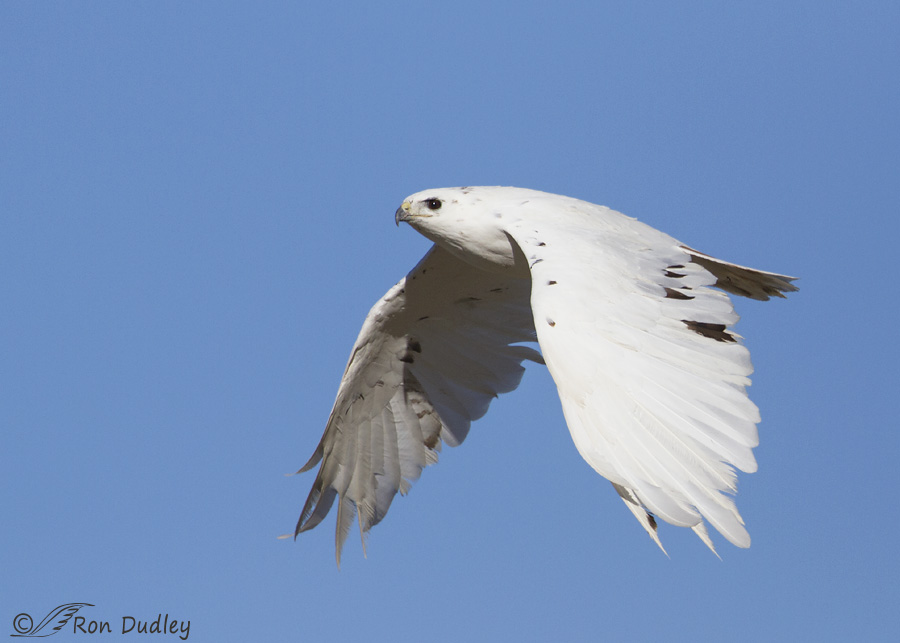 1/5000, f/6.3, ISO 500, Canon 7D, Canon EF 500mm f/4L IS II USM + EF 1.4 III Extender, not baited, set up or called in
1/5000, f/6.3, ISO 500, Canon 7D, Canon EF 500mm f/4L IS II USM + EF 1.4 III Extender, not baited, set up or called in
This shot is quite similar to the second image I posted here though the angle of attack is steeper and the wings are slightly lower.
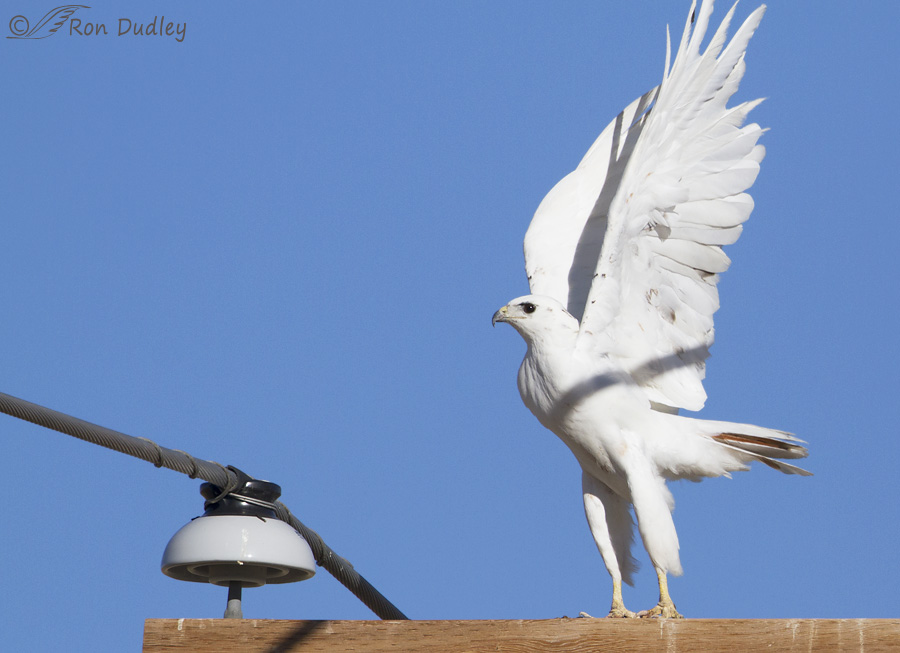 1/4000, f/6.3, ISO 400, Canon 7D, Canon EF 500mm f/4L IS II USM + EF 1.4 III Extender, not baited, set up or called in
1/4000, f/6.3, ISO 400, Canon 7D, Canon EF 500mm f/4L IS II USM + EF 1.4 III Extender, not baited, set up or called in
And yup, you guessed it. I clipped a wing when the hawk eventually took off from the second pole (that’s embarrassing after what I said in yesterday’s post…). But this dramatic stretched-out posture reveals more of the spectacular and unusual coloration of the bird. Note the hints of red in the tail and the dark eye indicating this hawk is an adult (and not an albino – more about that later).
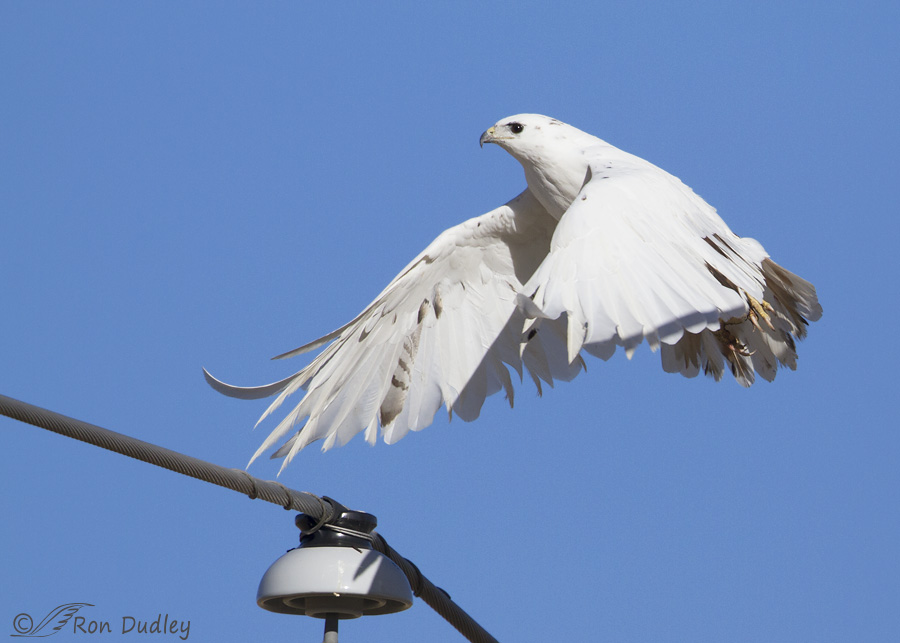 1/4000, f/6.3, ISO 400, Canon 7D, Canon EF 500mm f/4L IS II USM + EF 1.4 III Extender, not baited, set up or called in
1/4000, f/6.3, ISO 400, Canon 7D, Canon EF 500mm f/4L IS II USM + EF 1.4 III Extender, not baited, set up or called in
As the hawk cleared the wire…
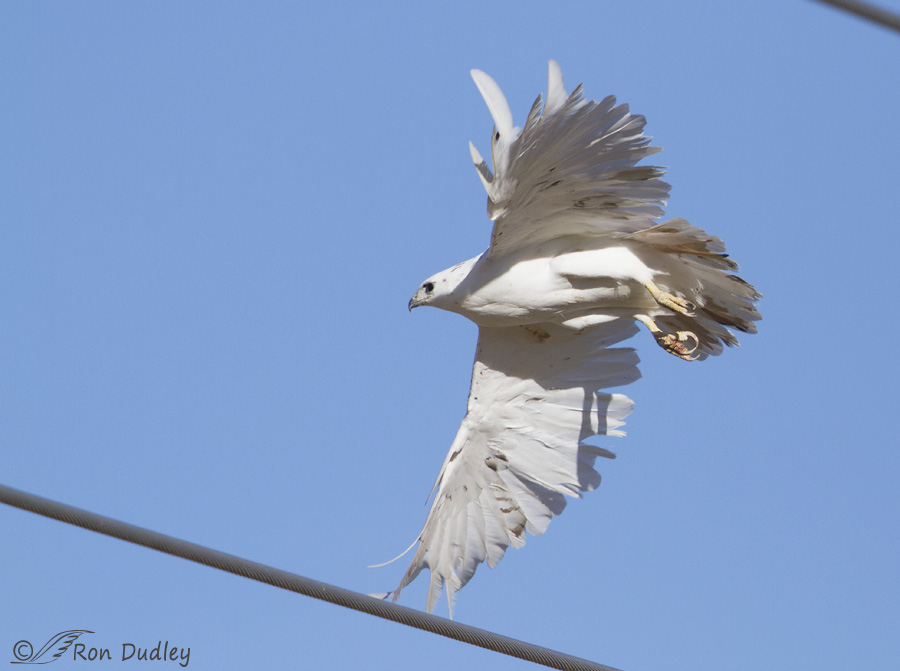
1/4000, f/6.3, ISO 400, Canon 7D, Canon EF 500mm f/4L IS II USM + EF 1.4 III Extender, not baited, set up or called in
it began to turn away from me so this is the last shot I’ll post. I only include this one because it shows us nearly all of the ventral surface of the bird.
I suspect at least some of my readers may have some questions about leucism so I include the following information for those with the interest:
- Leucism is an abnormal genetic mutation that prevents pigments (melanin in particular) from being deposited on feathers. The results are variable – from white patches where there shouldn’t be any to a paler overall plumage that looks diluted or bleached to an overall white plumage with little or no color visible.
- Leucism is not albinism. Only the plumage is affected in leucistic birds while albinism affects all pigments in the body. As a result albino birds show pink or reddish eyes, legs and feet and a pale bill. Leucistic birds typically have normally colored eyes, legs, feet and bills.
- Survival is often a challenge for leucistic birds: It robs them of effective camouflage. Since pigments are an important structural component of feathers their feathers may be weaker, more fragile and less effective insulators. White feathers reflect heat more efficiently so birds that rely on sunbathing and solar radiation for heat in winter may be at a distinct disadvantage. And finally, in many bird species color plays an important role in courtship rituals so leucistic individuals may be unable to find strong, healthy mates.
It’s been a long time since I’ve been this excited about a bird I’ve photographed – this one actually gave me buck fever. True, the light was a little bright and slightly harsh, especially for a white bird, but just seeing a hawk like this one was a milestone for me. Getting decent flight shots of it was the most delicious icing on the cake I can imagine.
Ron
PS – just for the record, for their protection it’s my policy to not reveal locations of rare or sensitive birds.


Wow, Ron! That is an incredible sight to behold. I absolutely love seeing your amazing photographs. I can’t thank you enough for sharing this unique bird. Your descriptions of the photographs make me feel like I was sitting next to you in your truck. My eyes have actually had tears in them while reading many of your blogs, as your adventures are absolutely thrilling to me. Your unique “I clipped a wing, dag nabbit” posts, that show that you are a human still learning and growing in your craft, are hard to find in these days. Thank you!
Thank you for sharing this most special bird. Also I do love your description as always. Thanks too for protecting it’s privacy. That is an admirable policy and no surprise to me that you follow it. I do love the one where it is standing tall and stretching everything. Good luck to him/her
Ain’t nature amazing! Wow. Just. Wow.
Wow!!! Gorgeous. And thank you for not ratting the bird out. It deserves some privacy. Good for you for spotting it. 🙂
Wow nice find. I hope it does well and has a long life.
Me too, April.
Was that in Kentucky?
No.
Just OH WOW! Remember that string of exclamations and excited superlative verbiage(s)? Insert that here! OH WOW! As you know, I’m truly fascinated with redtails in all their diversity from the deep dark chocolate brown, through Harlan’s, dark morphs, regulars, light morphs, Krider’s, leucistic and even albinos. I’m not fussy at all 🙂
That I have one sitting on a perch near me doesn’t affect my wonder at these birds in the wild even one little bit. But she’s taught me so much about that wonder.
I knew you wouldn’t divulge his/her location. That’s the kind of ethical guy you are and I SO appreciate that.
I figured you’d like this one, Laura. Thanks very much.
Holy Moly..I have never seen a Leucistic Red-tail. Lucky you!!! I’m so glad you were able to photograph the bird. I enjoyed all of the pics, but I especially like the last two shots. It shows the different colors in the feathering. Thanks Ron. I’m sure everyone here has a smile on their face.
Thank you, Jean.
OMG!! WHAT AN ASWESOME EXPERIENCE AND SHOTS RON!!!! Better you than me, I would have been paralyzed by the sight! LOL
Thanks for sharing!
Charlotte
I guess I should be thankful I didn’t freeze up. I think I was shaking slightly from excitement though. Or maybe it was out of fear that I’d screw up the flight shots.
Amazing.
Thank you so much for answering the question I left for Mia. I wondered whether their colouring had any impact on survival. I assumed it did, but didn’t know.
An already hard life made harder.
You and Mia must have been walking on air, with smiles threatening to split your faces.
We were, EC – we certainly were. It was about all we could talk about on the way home.
Ron, thanks for thee images. I especially like the last one where I can see, I think, the image of its legs on is right wing. Spectacular does not describe it. Diana
Yes, that’s exactly what you’re seeing, Diana. Thank you.
Beautiful…
Thanks, Patty.
An interesting coincidence–just last night, friends and I were discussing a leucistic roadrunner which once upon a time inhabited a nearby neighborhood . Sadly, he wasn’t around very long;
we speculated that , particularly at night, his coloration made him an easier target for coyote or other nocturnal predation.
I’d like to have seen your roadrunner, Kris.
What fun!
🙂
I so enjoy your photography. I love birds and am so impressed and thankful for all your knowledge about birds. Thank you for sharing.
Thanks very much, Betty.
My experience with leucistic birds indicates that they sometimes get MORE white feathers as they age; they don’t come out of juvenal plumage this white. That and the dark eyes would seem to say this is a bird that’s been around for a while making it. White feathers are typically weaker than others (we’ll often get a juvenile red-tail in with scalloped chest feathers because parasites have nibbled the white edges), so a lot of white birds have black wing tips. This guy definitely looked a bit tattered. So gorgeous, though!
“they sometimes get MORE white feathers as they age”
Wow, that’s fascinating, Louise. Thanks for the info.
A friend told me this morning about an individual bird (can’t remember the species) that alternates between leucistic and normal plumage every time it molts. If that’s truly the case what an interesting bird it would be.
Ron, have you ever seen or photographed a bird that is partly, but not completely leucistic? I remember as a kid that we had a robin with half a white head, which showed up on the farm in the spring, for several years in a row. Maybe all robins return each year to the same spot to nest, but since this one was unique, I could recognize him.
Marvin, what you describe isn’t unusual at all in leucistic birds. Many of them have only minor patches of white feathers.
Amazing… If never heard of leucistic until this year – there is a leucistic hummer at the uc Santa Cruz botanical gardens… And then someone in the birding ca Facebook group found one in Sonoma co… Wild… Is something in the environment contributing to this phenomenon?
I don’t know, Nicole. Leucism is genetic but environmental contaminants (among many other things) are known to cause changes in DNA.
Thanks for capturing and sharing this wonderful series.
Thanks for appreciating it, Nancy.
Congratulations Ron…excellent pics. Good exposure on a white bird too. I was thrilled to see this and happy that you got to experience it 🙂
That WAS a tough exposure, Zaphir. I had to play with it a little during processing to make the bird look as good as it does.
I was not familiar with the term leucism, although it was immediately obvious that this bird was not albino. From your description it reminds me of the piebald deer we’ve seen at the beach. In that case the genetic mutation causes sterility. In your last shot I was struck by how disorganized (for want of a better word) the feathers are on this bird. I’ve never seen a bird look so fluffy in flight before. I can see why you were so excited to see this one. I’m glad you did, both for your sake and for ours. More good learning for us.
Susan, I believe that some folks refer to leucistic birds that aren’t completely white as piebald too.
Spectacular series, Ron! So glad you were able to get multiple shots so we all get to enjoy this bird in all of it’s unique beauty. Well done!
Thank you, Diane.
You must feel like you just won the world Series with a Home Run in the bottom of the 9th. We forgive the swing and a miss with the clipped wing. What clipped wing?
Ron and Mia win! Ron and Mia WIN! RON AND MIA WIN!! Yea!
That’s pretty much how we feel, Neil.
Wow, what a cool looking bird! And I think your pictures are great. I can understand your excitement in seeing it. I once saw a melanistic Pileated Woodpecker in the Okefenokee Swamp and my heart was pounding so fast! It was completely black except for a red crest and moustachial stripe, no white on it whatsoever.
I’d love to have seen your woodpecker, Marya.
What an amazing sight. Fantastic shots and as always, I enjoy your narrative.
Thanks, Traci.
Wow! Very nice Ron. Great images. Thanks for the info on leucism too.
Thank you, Ed.
What a beautiful white red tail hawk you found. Photos are just gorgeous. I do feel a bit sad for him/her though because leucistic birds are looked down upon by other birds.They tend to have a lonely life. I hope this one is luckier. Great catch!!
Thanks, Debbie. Maybe this bird will find a color blind mate! 🙂
Wow Ron, what a great find. I can tell, you are not excited at all. And, you got some great shots as well. Congratulations! I am not even sure I can pronounce the word leucism, but I have been lucky enough to photograph a couple of birds showing this characteristic, one a Grebe (I think a pied billed) at the bird preserve in Henderson Nevada and a Greater Sandhill at Bosque del Apache in New Mexico. Both experiences “made my day”. Another great post and appreciate your ongoing efforts to help make many of our days much more entertaining. Hope your 7D2 issues will soon be resolved.
Frank, For years I’ve been wondering why I’ve almost never seen leucistic birds when others see them more often and I spend SO MUCH time in the field. This was a fun bird for me, that’s for sure.
Standout shots Ron, Congratulations!!
Since this is an adult, it seems that it has been successful up to now! It must have a different attack strategy that is working for him/her.
Whenever I hear or see leucistic birds I always wonder about the genetics and what the offspring would be if two leucistic adults get together.
I’ve wondered the same thing, Dick. How is leucism inherited? Is it a dominant or recessive gene? Or is the condition controlled by multiple genes? Many other questions too. Later today I’m sure I’ll be doing some additional research…
Amazing. Never knew such birds existed. Congratulations, Ron. For your high ethical standards and your generous sharing of what you have seen in the world, you deserved to find and photograph this remarkable hawk.
Elizabeth
Thanks, Elizabeth. I don’t know if I “deserved” it or not but I’ll sure as heck TAKE it!
What, in particular, helped you make the ID as a Red tail Hawk?
Among other factors the red in the tail was key (leucistic birds often have at least some normal plumage). Plus it was confirmed someone whose ID skills are significantly better than mine.
WOW! Absolutely stunning! 🙂 Gorgeous bird and shots of it even if it’s coloring may be a handicap. If it made it to adulthood some things must be working for it. It is the photo of a lifetime!
That’s what I keep thinking, Judy. With all the disadvantages this bird must face it’s impressive that it’s made it to adulthood.
Photo of a lifetime awesome!
Thank you, Bob.